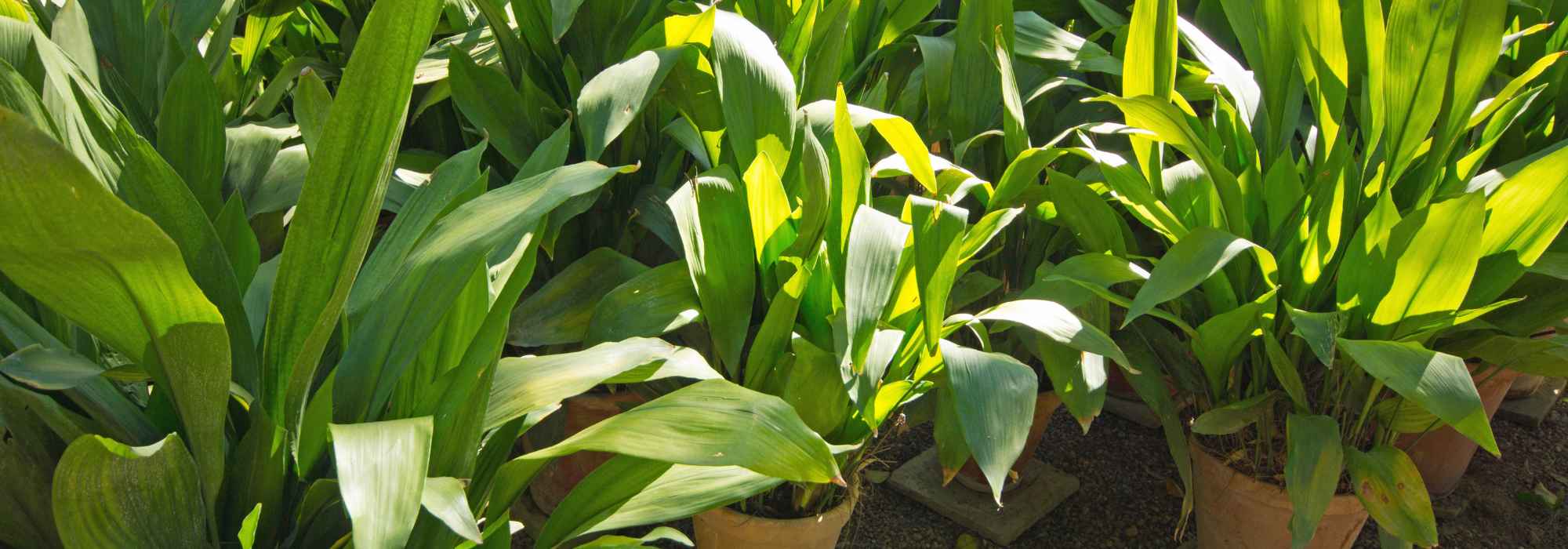
Aspidistra, Cast-iron plant: cultivating and care
Contents
Aspidistra in a nutshell
- Nicknamed mother-in-law’s tongue, this evergreen plant is prized for its long, dark green leaves, often variegated with white or cream
- Low-maintenance and adaptable, it is very easy to grow indoors
- It tolerates dry shade and proves hardy in the ground in our mildest regions
- It forms large clumps of upright, lush leaves
- In the garden, it thrives in shaded spots without direct sunlight
The word from our expert
Aspidistra is the quintessential green plant of our grandmothers’ interiors! Nicknamed “mother-in-law’s tongue” (like the Sansevieria), this perennial plant, as elegant as it is lush, charms with its easy care, forgiving forgotten waterings, care, and attention! It adapts perfectly to life indoors or outdoors. Commonly referred to as the “cast iron plant” due to its resilience to harsh environmental conditions, the Aspidistra is a true symbol of tolerance and adaptability, much like the Aspidistra elatior (Cast Iron Plant), the most widely cultivated species. While this variety boasts deep green evergreen leaves, others, like ‘Variegata’, stand out with strikingly bright and original variegated foliage. Its fascinating flowers appear at the base of the plant, at soil level, and are typically a deep purple colour.
Today, even though it naturally thrives in pots on windowsills or balconies, the Aspidistra is making its way into gardens, as what many don’t know is that it is hardy down to -12 to -15°C, allowing it to be planted directly in the ground in zone 7. It tolerates all non-scorching exposures, requires no maintenance, and simply asks for well-drained soil. This plant can survive neglect, making it a top choice for novice gardeners or those with little time to spare.
Discover or rediscover this nearly foolproof plant, perfect for dry and shady garden areas, low-maintenance gardens, or simply to green up your indoor spaces!
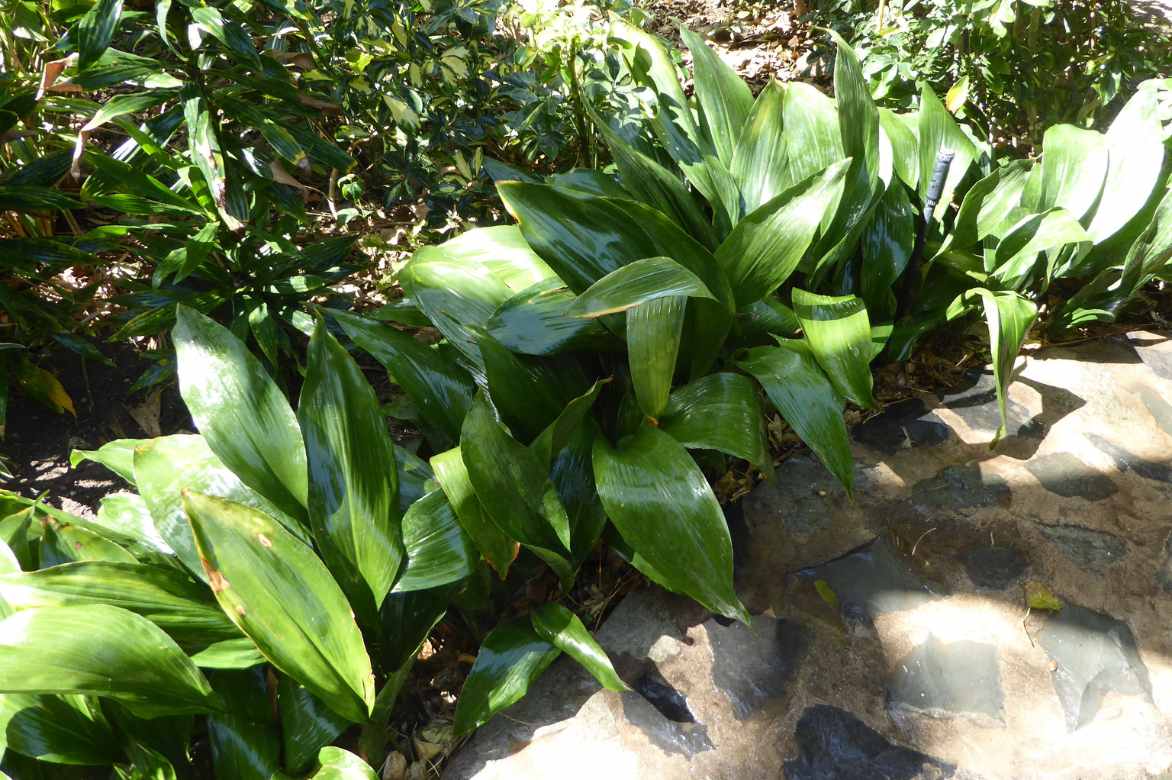
Aspidistra elatior: just as easy in the garden as indoors! (© Gwenaelle David Author)
Description and Botany
Botanical data
- Latin name Aspidistra
- Family Convallariaceae
- Common name Aspidistra, mother-in-law's tongue, cast-iron plant
- Flowering February-March or June
- Height 0.30 to 50 cm
- Exposure partial shade, shade
- Soil type Light, fresh to dry, well-drained
- Hardiness -12-15 °C, varies by species
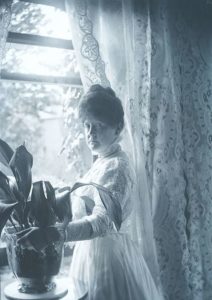
Aspidistra in a Victorian interior
Aspidistra is a perennial rhizomatous plant from the Convallariaceae family, much like lily of the valley and Liriope muscari. There are around 60 species, among which the tall Aspidistra (Aspidistra elatior), also nicknamed “mother-in-law’s tongue”, is the most commonly grown in our homes. The Aspidistra linearifolia, with narrow leaves, the Aspidistra hainanensis, with linear leaves, or the Aspidistra sichuanensis and Aspidistra minutiflora, speckled with light green or white, enrich the genus. This Asian perennial plant originates from Taiwan and Japan, where it grows in the undergrowth of Oshima Island. It has since naturalised in China. Appealing for its robustness and resistance to neglect and poor treatment, it was introduced as a houseplant in Europe as early as the 19th century, first in Great Britain, conquering Victorian interiors, then in our French and European living rooms. Such a degree of resilience earned it the nickname “cast-iron plant” across the Channel. Today, its qualities are being rediscovered, this time in the garden, as it is also an excellent evergreen and relatively hardy plant.
Aspidistra slowly develops, from a thick rhizome, a beautiful clump with a flexible habit, both upright and slightly fan-shaped, measuring 35-50 cm in all directions. The solitary, lanceolate, pointed, and leathery leaves, with a long rigid petiole, grow tightly packed together in a dense cluster. The leaves on the outer edge of the clump droop slightly. They can reach up to 50 cm in length and 8 to 10 cm in width. Over the years, the clump thickens without ever becoming invasive. Aspidistra is remarkable for its evergreen foliage in mild climates, very graphic for much of the year. The type species, Aspidistra elatior, with glossy green foliage, has given rise to varieties offering sumptuously variegated and subtly striped shades of cream and yellow; zebra-striped (‘Zebra’), variegated (‘Variegata’), spotted (‘Milky Way’), or striped (‘Lennon’s Song’).
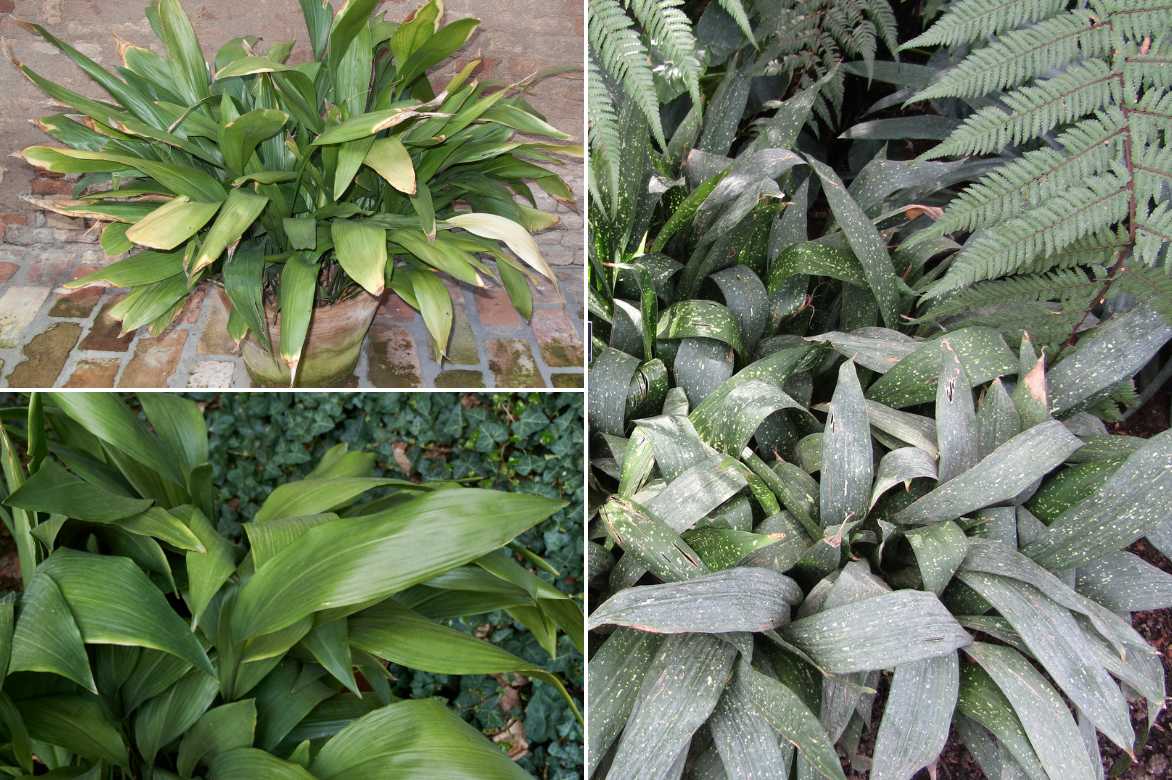
Aspidistra elatior on the left, and on the right, the spotted variety ‘Milky Way’ (© Leonora Enking)
The flowers of the Aspidistra are, to say the least, intriguing. The flowering, when it occurs, is much more discreet, though original, as it appears on mature plants at the base of the leaf clumps. Aspidistra only flowers when growing conditions are optimal (fresh and well-draining substrate, sufficient light but no direct sunlight). Nestled under the foliage, strange fleshy and waxy flowers appear from January to June. These true botanical curiosities take the form of upright bell-shaped flowers, 2-3 cm in diameter, composed of 8 purple lobes tapered at their tips. These solitary flowers blooming at ground level are pollinated by slugs and snails that relish their nectar. Despite their singular appearance, they emit a subtle fragrance that attracts pollinators. These strange and captivating flowers later turn into small spherical and dark berries.
Many species of Aspidistra are cultivated in botanical gardens in Asia. Aspidistra elatior is the green plant awarded by the Royal Horticultural Society with an Award of Garden Merit.
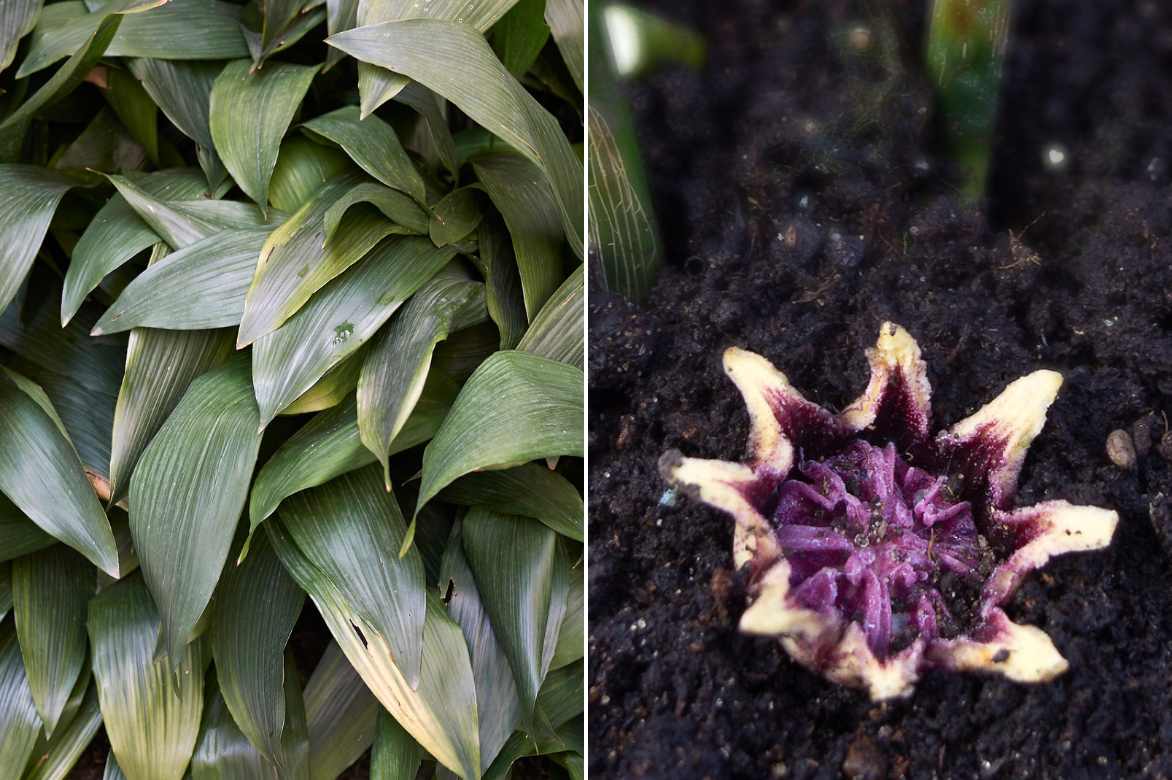
Aspidistra elatior: foliage, and on the right, the peculiar flower at ground level (© Stewart Black)
Main species and varieties
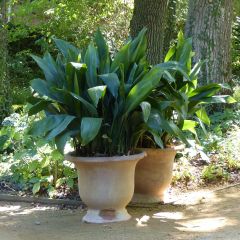
Aspidistra elatior - Cast-Iron Plant
- Mois de floraison July
- Hauteur à maturité 35 cm
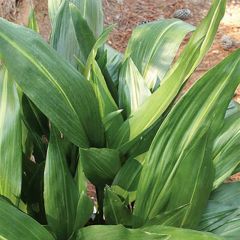
Aspidistra elatior Zebra - Cast-Iron Plant
- Mois de floraison July
- Hauteur à maturité 50 cm
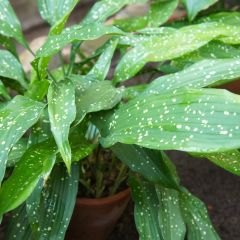
Aspidistra Milky Way - Cast-Iron Plant
- Mois de floraison July
- Hauteur à maturité 35 cm
Planting the aspidistra
Where to Plant It?
The Aspidistra has variable hardiness depending on the variety, but it is less delicate than it appears. The Aspidistra eliator is the hardiest species of all, tolerating short frosts of around -12 to -15°C. The foliage may crystallise under frost, but the plant can regrow from the stump in spring. It proves hardy in zones 7b and 8a. This is why, in most of our regions, it is typically grown in pots, to be brought indoors, sheltered from frost during winter. It is a robust and undemanding houseplant (not to say indestructible), which tolerates difficult living conditions (forgotten watering or repotting, cool rooms, lack of light, temperature fluctuations…) and will appreciate being taken outside during the warmer season, avoiding scorching sun and drafts. Indoors: it will thrive in your conservatory or living room, near a window or glass door, as it needs a bright spot. Be wary, however, of intense sunlight behind glass, which could scorch the foliage. This plant can grow in low-light environments, making it an ideal companion for dimly lit rooms. When temperatures exceed 15°C, you can place it on your terrace or balcony. Position the pot in a warm, sunny spot, sheltered from the coldest winds.
The Aspidistra can only be grown in the ground in the mildest areas of our country (zone 7b), even though it can tolerate brief frosts in well-drained soil. If your climate allows, you can grow it in the ground in dappled shade, even dry, under large trees, for example.
The Aspidistra loves partially shaded areas of the garden and accepts all non-scorching exposures. It even tolerates full shade, though it will be less exuberant there. In warm regions, prefer partial shade to prevent the scorching sun from drying out the foliage.
It thrives in humus-rich, slightly acidic soil (like heather soil), light, and always very well-drained. Although it prefers rich, well-drained soil, it also adapts to less fertile ground. In clay soil, ensure good drainage to prevent its roots from suffering from stagnant moisture in winter.
Its resilience in challenging conditions makes it suitable for many situations. It is ideal in light woodland to cover dry, shaded garden areas where nothing else grows, at the base of trees and bushes, on difficult slopes, along pathways, in shaded beds, or in cool rockeries. It is so accommodating that it will forgive forgotten watering and is an excellent candidate for gardens without gardeners or weekend gardens.
Its lush foliage makes it a perfect solution for large, luxuriant pots that can be kept on the balcony or terrace all summer or in the conservatory during winter.
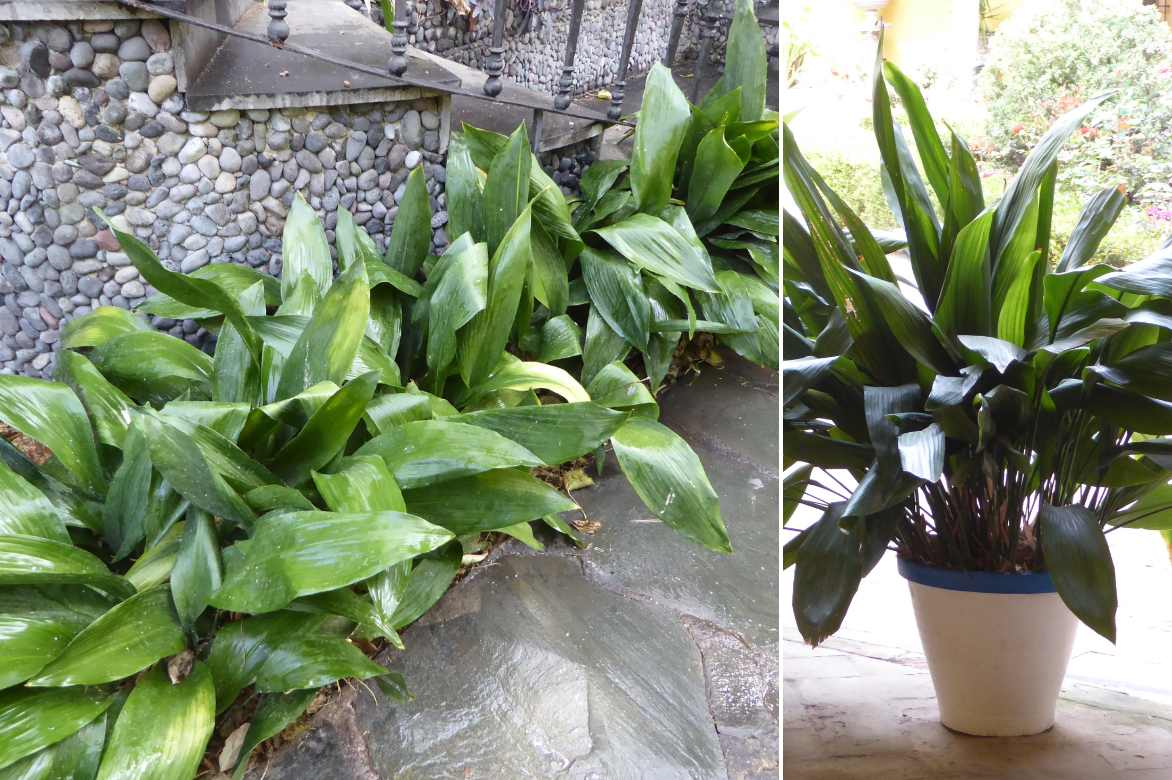
Aspidistras thrive in the ground or in attractive pots (© Gwenaelle David Authier)
When to Plant the Aspidistra?
In the ground, it can be planted in spring or autumn, once the risk of frost has passed. For pot cultivation indoors, you can plant it year-round.
How to Plant It?
In the Ground
Using a spade, prepare the soil by working it to a depth of 30 cm.
- Dig a hole 2 to 3 times wider than the root ball.
- Place the plant in the centre of the hole, keeping the collar of the root ball level with the soil.
- Fill with a mix of good compost and potting soil.
- Firm the soil.
- Water generously and regularly to encourage establishment.
In a Pot
- Choose a pot at least 30 cm in diameter and depth, with drainage holes.
- Place a layer of clay pebbles or gravel at the bottom to improve drainage.
- Fill the pot with part of the substrate: use a mix of good potting soil (houseplant compost), well-decomposed compost, and perlite to ensure good drainage and root aeration.
- Place the Aspidistra in the centre of the pot, ensuring the top of the root ball is no more than 3 cm below the rim.
- Fill with the remaining substrate, lightly firming to remove air pockets.
- Water thoroughly to encourage rooting.
- Bring the pot indoors to shelter from frost in autumn in colder regions.
Culture and care of the aspidistra
The Aspidistra is easy to cultivate in regions where the frost is not severe. Whether in pots or in the ground, it requires sufficient moisture at the base, especially during summers or if there is no rain.
In the garden
In the ground, the Aspidistra needs regular watering, particularly during the hottest and driest months. Keep the soil evenly moist but avoid waterlogging. During dry spells, water at least once a week. Once established, it can manage without watering. During cooler months, reduce watering.
In pots
In very mild regions, you can leave the pot outdoors all year round. In regions with colder winters, it is essential to overwinter your Aspidistra in a bright, frost-free room while maintaining watering. Throughout the year, water regularly without saturating the root ball. In summer: once or twice a week, and in winter, water approximately every two weeks. Ideally, keep the plants between 7°C and 10°C in winter. You can move your pot back outside in spring, once the risk of frost has passed, and acclimatise it gradually.
In pots, the substrate depletes much faster than in the ground. From March to August: use a liquid fertiliser for green plants once a month, bearing in mind that excess fertiliser can cause variegated cultivars to revert to green. Indoors: regularly clean the leaves with a damp sponge to remove dust.
→ To learn more, read our article: “Aspidistra Indoors: Seasonal Care Guide“.
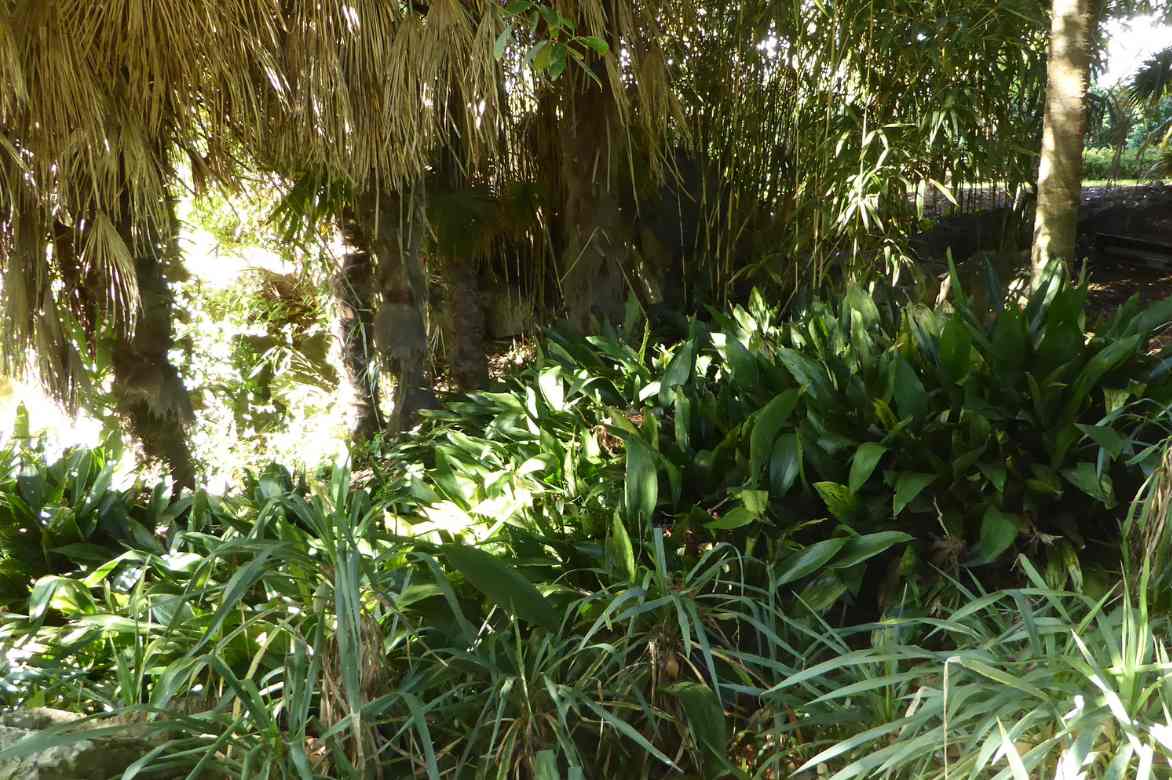
A mass planting of Aspidistras at the Jardin des Plantes in Nantes adorns an exotic space (©Gwenaelle David Authier)
Pruning
Maintenance simply involves tidying up the clumps at the end of winter: remove damaged, yellowed, or dead leaves by cutting them at the base to keep the plant clean and healthy.
Repotting
Every two years, in spring, repot your plant into a slightly larger pot. If the pot size and the size of your Aspidistra make this impossible, simply perform a top-dressing once a year in spring by replacing the old substrate on the top few centimetres with fresh compost.
→ Also read Pascale’s advice in How to Grow Aspidistra, Indoors and in the Garden?
Diseases and potential pests
Indoors, it can be sensitive to mealybugs. To get rid of them, spray rapeseed oil after removing them with a cloth soaked in alcohol. In spring, follow our advice to protect its young leaf from slugs and snails, which are fond of it.
Beware of excess water: overly moist soil may cause the leaf to turn yellow.
→ Read also: Diseases and parasitic pests of Aspidistra: identification and treatment.
Multiplication
Every two to three years, divide the clumps to multiply them. This division also helps rejuvenate the plant.
- Take fragments of rootstocks from the periphery, bearing a few leaves
- Replant immediately in pots with good soil
- Keep the substrate moist to encourage rooting
- Replant in the garden when the new young plants are sturdy
Associate
The Aspidistra is an essential perennial plant in shade gardens, where its evergreen green or variegated foliage brightens up shaded and wooded areas, as well as neglected corners. At the edge of woodlands, in rockeries or flower beds, it pairs beautifully with other shade-loving perennials such as ferns and hostas. Its slender leaves create a striking contrast with the broader, more flexible habit of Osmundas, such as the Osmunda regalis ‘Purpurascens’. With its ground-covering qualities, it perfectly complements Epimedium, Asarum, or ground ivy (Glechoma hederacea).
Under trees, it will thrive alongside other shade-loving ground-cover perennials to create lush, colourful carpets of foliage, such as heucheras and Vinca.
As it prefers slightly acidic soil, it can create beautiful scenes alongside heather soil shrubs that thrive in shade or partial shade, such as camellias or rhododendrons.
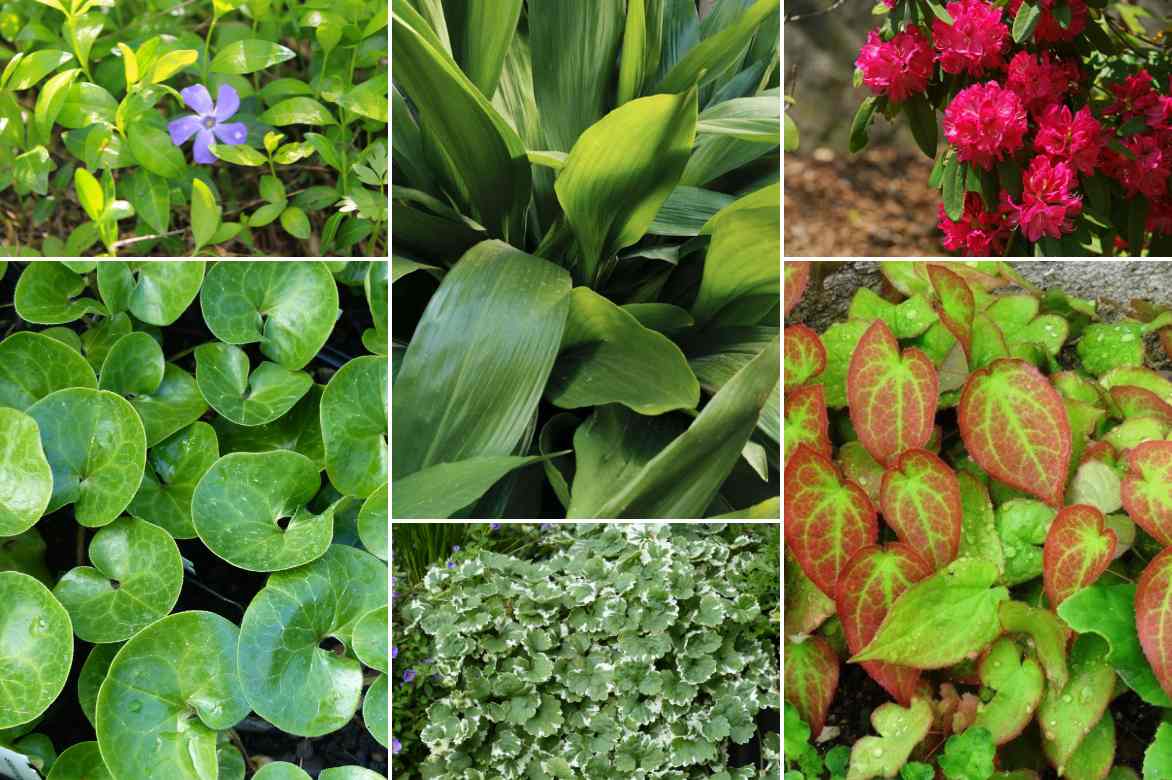
A few Aspidistras surrounded by Vinca minor (lesser periwinkle), a beautiful rhododendron, Asarum, Glecoma hederacea ‘Variegata’, and Epimedium warleyense
Useful resources
- What to plant under my trees?
- What are the best plants to grow in woodland areas ?
- Also check out our advice in: gardening in dry shade and perennials for dry shade
- Subscribe!
- Contents































Comments